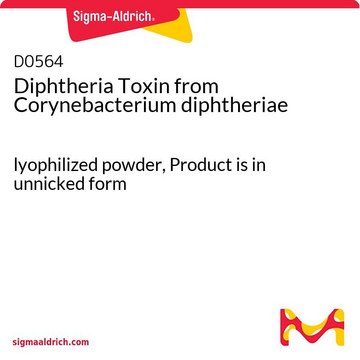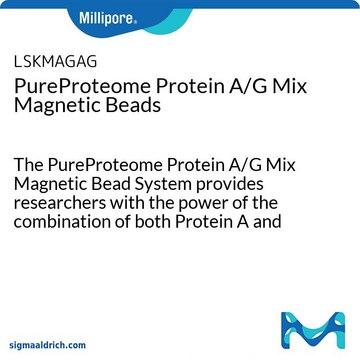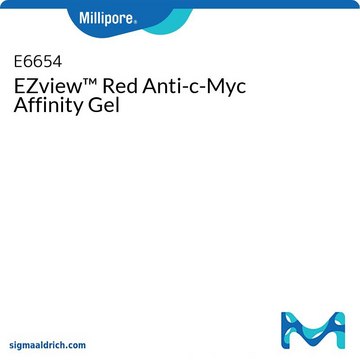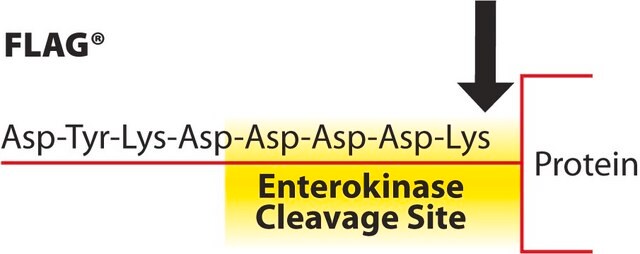E3403
EZview™ Red Protein G Affinity Gel
Synonym(s):
EZview Affinity Gel, Protein G Affinity Gel
Sign Into View Organizational & Contract Pricing
All Photos(1)
About This Item
Recommended Products
form
liquid
Quality Level
analyte chemical class(es)
proteins (Immunoglobulins of various mammalian species)
technique(s)
affinity chromatography: suitable
immunoprecipitation (IP): suitable
capacity
≥8 mg/mL, gel binding capacity (rabbit IgG)
storage temp.
−20°C
General description
EZ view Red Protein G Affinity Gel is Protein G covalently bonded to 4% Agarose beads. The affinity gel is used to bind the FC portion of the IgG of an antibody to samples, such as cell lysates and tissue, for purification of proteins in preparation of immunoprecipitation assays. Red dye enhances visability for more efficient results.
Application
When performing small-scale affinity capture, such as immunoprecipitation, the affinity matrix is difficult to see in the microcentrifuge tubes. Accidental aspiration of the resin leads to quantitative variability in results. The EZview™ Red Affinity Gels greatly reduce the risk of pellet loss. EZview resins perform as well as conventional non-colored affinity gels, but allow the user to easily differentiate pellet from supernatant. This correlates to more accurate data because less protein is lost.
Features and Benefits
- Increased visibility - Red color reduces risk of incidental aspiration
- Improved recovery of target protein by reduced accidental loss
- Higher reproducibility - More consistent yields
Physical form
1:1 (v/v) suspension in PBS containing 50% glycerol and 15 ppm Kathon
50% slurry in PBS with 50%Glycerol and 0.0015%
Legal Information
EZview is a trademark of Sigma-Aldrich Co. LLC
Storage Class Code
10 - Combustible liquids
WGK
WGK 3
Flash Point(F)
Not applicable
Flash Point(C)
Not applicable
Certificates of Analysis (COA)
Search for Certificates of Analysis (COA) by entering the products Lot/Batch Number. Lot and Batch Numbers can be found on a product’s label following the words ‘Lot’ or ‘Batch’.
Already Own This Product?
Find documentation for the products that you have recently purchased in the Document Library.
Customers Also Viewed
Min Mo et al.
Proceedings of the National Academy of Sciences of the United States of America, 106(46), 19527-19532 (2009-11-06)
The anaphase-promoting complex (APC), or cyclosome, is a ubiquitin ligase with major roles in cell cycle regulation. It is required for mitotic exit, but must be deactivated for the G(1)/S phase transition to occur. APC consists of at least 12
Yuval Malka et al.
Nature communications, 8(1), 2029-2029 (2017-12-13)
The majority of mammalian genes contain one or more alternative polyadenylation sites. Choice of polyadenylation sites was suggested as one of the underlying mechanisms for generating longer/shorter transcript isoforms. Here, we demonstrate that mature mRNA transcripts can undergo additional cleavage and
Alvaro Quintanal-Villalonga et al.
Lung cancer (Amsterdam, Netherlands), 131, 112-121 (2019-04-28)
Lung adenocarcinoma accounts for approximately half of lung cancer cases. Twenty to 50% of tumors of this type harbor mutations affecting epidermal growth factor receptor (EGFR) expression or activity, which can be therapeutically targeted. EGFR inhibitors in this context exhibit
Álvaro Quintanal-Villalonga et al.
EBioMedicine, 53, 102683-102683 (2020-03-03)
Fibroblast growth factor receptor (FGFR)1 and FGFR4 have been associated with tumorigenesis in a variety of tumour types. As a therapeutic approach, their inhibition has been attempted in different types of malignancies, including lung cancer, and was initially focused on
Juri Kazakevych et al.
Nucleic acids research, 45(10), 5770-5784 (2017-03-24)
Epigenetic mechanisms, including chromatin structure, chromatin dynamics and histone modifications play an important role for maintenance and differentiation of pluripotent embryonic stem cells. However, little is known about the molecular mechanisms of adult stem cell specification and differentiation. Here, we
Our team of scientists has experience in all areas of research including Life Science, Material Science, Chemical Synthesis, Chromatography, Analytical and many others.
Contact Technical Service










